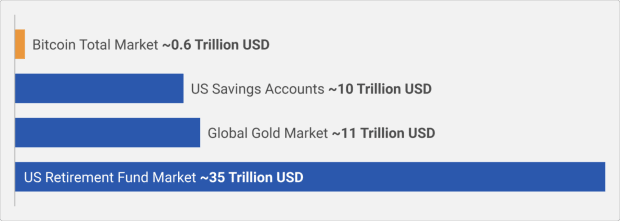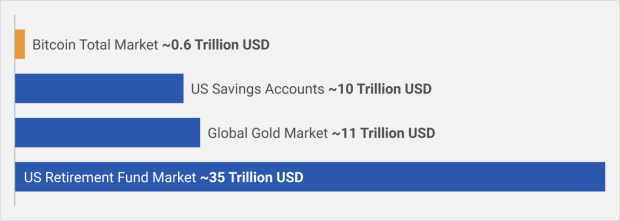American retirement savings represent a new beachhead for bitcoin — we just need to make sure people hold their own keys.
“Many adults are struggling to save for retirement and feel that they are not on track with their savings. While preparedness for retirement increases with age, concerns about inadequate savings are still common for those near retirement age.” —Federal Reserve Website
Despite the Federal Reserve’s tone-deaf admission that many Americans struggle to retire when one of the central bank’s primary mandates is price stability, as of March 2021, there were approximately $35.4 trillion trapped in tax-advantaged retirement accounts. For many Americans, retirement accounts make up a vast majority of their overall net worth.
As the dollar continues to inflate and bitcoin continues to outperform any other form of savings, it’s natural that Americans will increasingly tap into their retirement savings to gain exposure to bitcoin. This is great news for bitcoin, but many risks emerge if these funds ultimately centralize in a few custodians’ hands.
Contrary to what many Americans might expect, anyone can hold the private keys to their bitcoin IRA instead of relying on a third party. However, navigating the US retirement rules and regulations can be difficult. This article can be used as a high-level starting point but nothing in this article should be taken as financial advice.
How U.S. Retirement Accounts Work
Retirement accounts (such as IRAs, 401(k)s, 403(b)s, 457 plans and others) allow contributions in the form of traditional funds, Roth funds or a mixture of both.
- Traditional retirement account: Contributions receive an up-front tax deduction or exclusion from taxable income. Those traditional funds can be withdrawn after age 59.5 without penalty, but they will still be taxed upon withdrawal at ordinary income tax rates.
- Roth retirement account: Contributions receive no up-front tax benefit. However, after age 59.5, all Roth funds — including all appreciation — may be withdrawn completely tax-free.
In either a traditional or Roth account, all capital gains and other investment income are free of tax as the assets grow.
Bitcoin: The Retirement Inflation Hedge
Historically, the 5 to 8% annual yield delivered by typical retirement accounts may have surpassed the real inflation rate of the dollar. Regardless, it definitely beat the official government-reported inflation rate. In 2021, however, there is no serious argument that such a yield is outpacing inflation.
Fortunately, today we have bitcoin, a revolution in savings technology with average yields over 100% per year when measured in U.S. dollar terms (past performance is no guarantee of future results). With its strict supply limit, bitcoin is an attractive savings vehicle for funds not intended to be touched for a few decades.
Unfortunately, marrying this new savings technology with traditional savings vehicles such as retirement accounts typically require significant trade-offs. Legacy retirement accounts, at best, might offer investments in the Grayscale Bitcoin Trust (GBTC) or stock in companies that hold large bitcoin reserves such as MicroStrategy (MSTR). But either of those options requires trusting the relevant institutions to actually hold all of the bitcoin they claim to hold (don’t trust, verify). And none of those investments grant savers access to any keys, putting the institutions in total control of your retirement’s destiny.
Enter The Self-Directed Checkbook IRA
Fortunately, a growing number of companies can help you use your retirement funds to buy bitcoin and hold the keys yourself. A self-custodied Bitcoin IRA combines the best of bitcoin self-sovereignty with retirement tax optimization.
Instead of leaving a large portion of your wealth invested in assets that are barely keeping up with inflation in a legacy IRA or 401(k), you can introduce bitcoin, the strongest currency that the world has ever seen, into your retirement portfolio by using just a couple of hardware wallets and completing some legal paperwork.
How Does A Bitcoin IRA Work?
The best bitcoin IRAs use a structure known as a self-directed checkbook IRA. This is an IRA that provides you with total control over your retirement assets. Unlike the first generation of self-directed IRAs, self-directed checkbook IRAs allow the underlying assets to be custodied by you instead of an IRA custodian.
Structurally speaking, in a self-directed checkbook IRA, your IRA owns one singular asset: an investment trust entity. That investment trust owns your underlying investment assets (in our case, bitcoin). Despite the investment trust being owned by your IRA rather than by you directly, you are sole named trustee. This means that you and only you are in charge of investment selection and custody.
Here are the five basic steps to convert a portion of your retirement to bitcoin and hold your own keys:
- Set up an investment trust (the most common checkbook entity used today, although in the past sometimes LLCs were used instead).
- Set up a custodial IRA account with a licensed IRA custodian that accepts checkbook-style investments.
- Rollover (transfer) your legacy retirement account into the new IRA account and direct the IRA custodian to invest into your investment trust, which means they move your retirement funds into your trust’s checking account.
- Onboard your investment trust with an exchange, linking the investment trust’s checking account.
- Purchase bitcoin and secure it in cold storage with your private keys.
Common Questions About Self-Directed IRAs
Why not just liquidate the old retirement account to buy bitcoin?
Early withdrawals from retirement accounts come with taxes and steep penalties, sometimes up to 40%. Getting 40% more bitcoin today is significantly better than taking the tax hit. You’d also miss out on the tax benefits of holding bitcoin in a retirement vehicle.
Isn’t a retirement account antithetical to bitcoin?
Purchasing bitcoin in a retirement account while holding your own keys combines the sovereignty, permissionlessness, and savings power of Bitcoin with the lesser-known opportunities available in the legacy financial system. Even though your licensed IRA custodian technically holds the IRA, you hold the private keys to the bitcoin addresses. Not your keys, not your bitcoin.
Why not just wait for an ETF?
An ETF will not allow you to hold the private keys to your retirement. A centralized custodian will still hold your bitcoin. An ETF will be far less secure from remote hacks or custodial hacks and significantly more prone to confiscation. Further, future Bitcoin ETFs will most likely function as bitcoin derivatives lacking the safety of real bitcoin. It’s also worth noting that we’ve all been waiting for a bitcoin ETF since 2015, to no avail.
What’s the best way to do this?
The company I work for, Unchained Capital, has published a comprehensive guide with the KeyKeeper IRA team. Out of the available options for self-custodied IRAs, I’m confident we have the smoothest and fastest process to get a portion of your retirement accounts rolled over and bitcoin delivered to your cold storage.
However, there are other options for bitcoin IRAs out there. Here are four things to consider when investigating:
- Can you hold the keys to your retirement account’s bitcoin?
- What is the fee to purchase bitcoin and are there limitations to where you can buy it? Marking up bitcoin purchases is how many of these companies make their money.
- What is the annual fee for the accounts and is there a charge based on assets under management? You don’t want your retirement accounts to get more expensive as the value of bitcoin increases.
- What is the timeline from start to finish? It can be painful for your retirement funds to be out of the bitcoin market for extended periods if you try to exit GBTC.
What about privacy?
As with any IRA, the year-end value of a bitcoin IRA must be reported to the IRS annually. It is important to note that this disclosure is only of the U.S. dollar value of the holdings, not of any bitcoin addresses or other data. Regardless of whether you secure your bitcoin in collaborative custody with a provider like Unchained Capital, in your own multisig setup or with a single hardware wallet in a drawer, the reporting obligation remains the same. With this in mind, eliminating single points of failure with a collaborative custody vault has very little downside.
The annual reporting requirements are a trade-off when considering whether to set up a bitcoin IRA. But if you have existing retirement accounts that you want to rollover into bitcoin, the alternative is making an early withdrawal and paying the penalty, making the one-time privacy trade-off when purchasing bitcoin from an exchange, and ending up with up to 40% less bitcoin as a result.
Conclusion
U.S. retirement accounts are currently sitting on the melting ice cube of the devaluing dollar. Moving retirement assets into bitcoin opens up the opportunity to convert some of the $35.4 trillion stuck in these accounts to bitcoin secured by millions of private keys distributed among millions of Americans. This is the greatest untapped source of American “dry powder” that can flow into Bitcoin. Still, this transfer must be undertaken intelligently while educating savers about the benefits of holding private keys.
Controlling the private keys to your retirement is a large responsibility. But holding your private keys is the only reliable way to protect Bitcoin savings from hacks, inside jobs, central bank debasement, haircuts and confiscations. The process is consistently getting easier. Due to the superior security that comes with holding private keys, we believe over a billion people will hold the keys to their wealth within the next few decades.
Not your keys, not your retirement.
This is a guest post by Phil Geiger. Opinions expressed are entirely their own and do not necessarily reflect those of BTC, Inc. or Bitcoin Magazine.







 BTC-USD
BTC-USD  ETH-USD
ETH-USD  LTC-USD
LTC-USD  XRP-USD
XRP-USD